Growth Loops: Definition, Types, Examples, and Implementation
Growth loops might not be the easiest to implement in a business, but it offers the most efficiency. That’s precisely why it has become the most dominant framework for product growth since its introduction in the business world. Perhaps its only downside is that it takes a deep understanding of the concept in order to leverage it.
With that said, today, we’ll discuss the definition of growth loops, their types, examples, and how to properly implement them. Without further ado, let’s start.
Table of Contents
- What are growth loops?
- Sales funnel model vs growth loops
- Real-life examples of successful growth loops
- Main types of growth loops
- How to implement growth loops in your business
- The bottom line: growth loops
- Machine Learning In Finance: 12 Essential Applications
- How To Create Interactive Compliance Training For Bank Employees
- How Fintech Apps Are Using Gamification To Increase User Engagement
- Top Gamification Companies for Employee & Customer Engagement
What are growth loops?
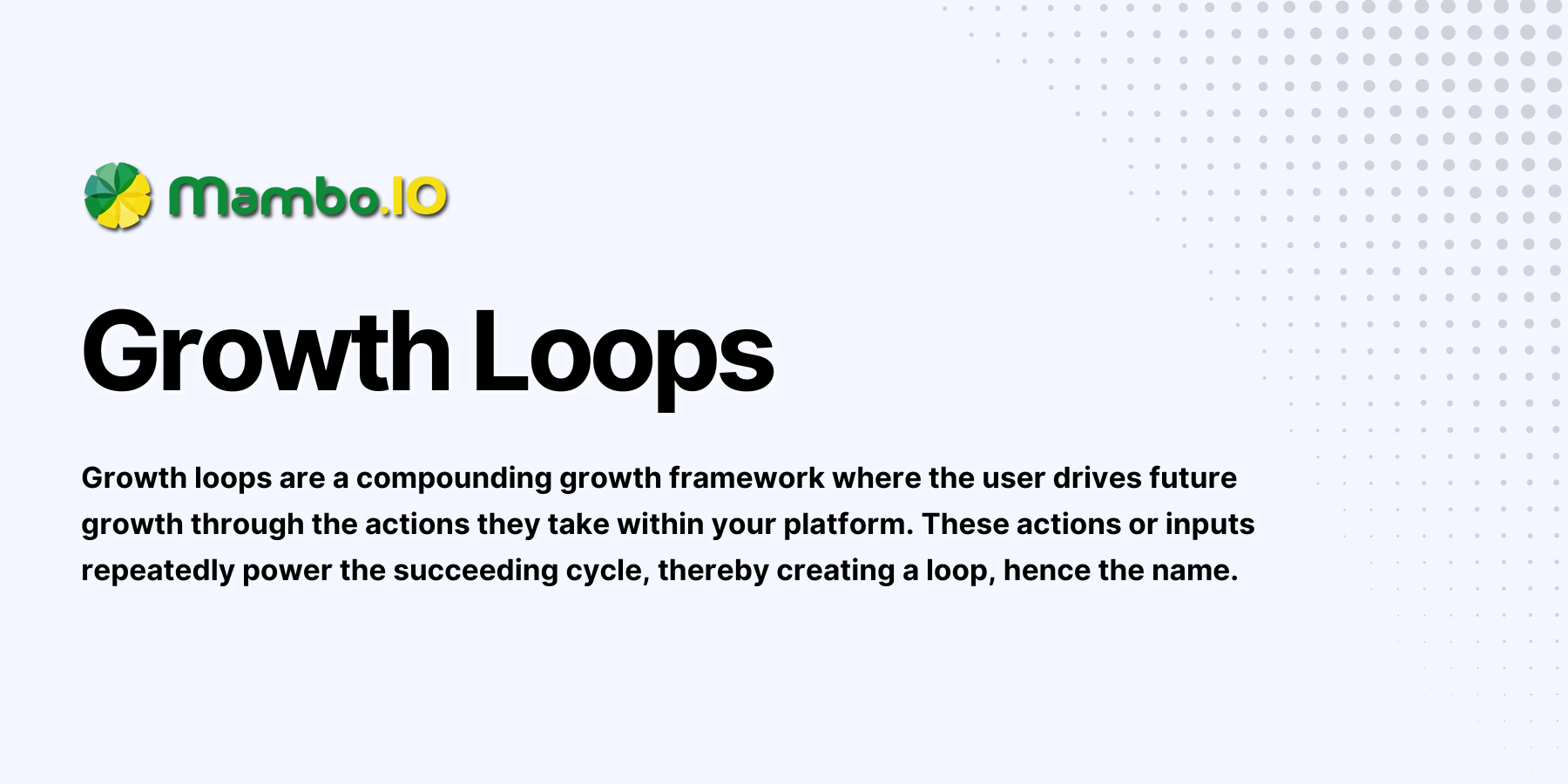
Growth loops are a framework or concept that revolves around creating a self-sustainable cycle of growth in a business.
This is accomplished by using outputs from the previous growth cycle as inputs for the next cycle, creating a loop.
To illustrate further, it would be best to look at it compared to the traditional framework—the sales funnel growth model.
Sales funnel model vs growth loops
The sales funnel model, unlike growth loops, follows a linear process.
If the illustration of growth loops are circles, the sales funnel model can be described as a funnel. Each stage gets narrower and narrower as it covers fewer people. Moreover, there’s an explicit end to one cycle and an explicit start to the next.
4 stages of the sales funnel model
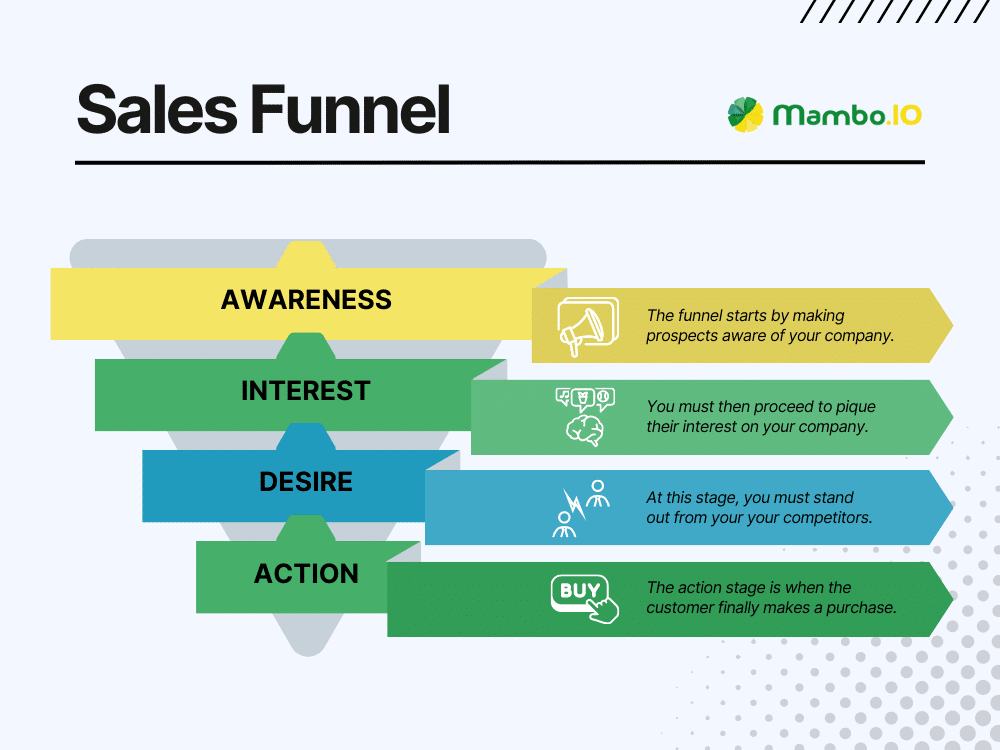
The sales funnel model consists of four stages, and it goes like this:
#1. Awareness
The funnel model starts by making prospects aware of your company.
This may be through social media posts, articles like this guide, or paid advertisements. This generally covers a relatively wide audience.
#2. Interest
Once the prospects are aware of the company, you may proceed to pique their interest.
One strategy would be to provide more details about your products and services.
You can also address their pain points. However, in this context, there’s a possibility that they take an interest in companies offering similar products, a.k.a. your competitors.
#3. Desire
The desire stage is all about standing out from your competitors. It encompasses the actions you must take to ensure your leads choose your company.
In short, you must stand out. Common strategies to create desire include samples, free trials, testimonials, and case studies.
#4. Action
The action stage is more so a stage the customer must fulfil rather than you. It’s when you convert a lead into a customer as they finally make a purchase.
Once a customer goes through a sales funnel, their role in this growth strategy ends. To acquire new leads and customers, you must do it all over again. If your awareness stage consists of using Google Ads, for instance, then you’d have to invest in it again.
With growth loops, however, things are a bit different.
3 stages of the growth loop framework
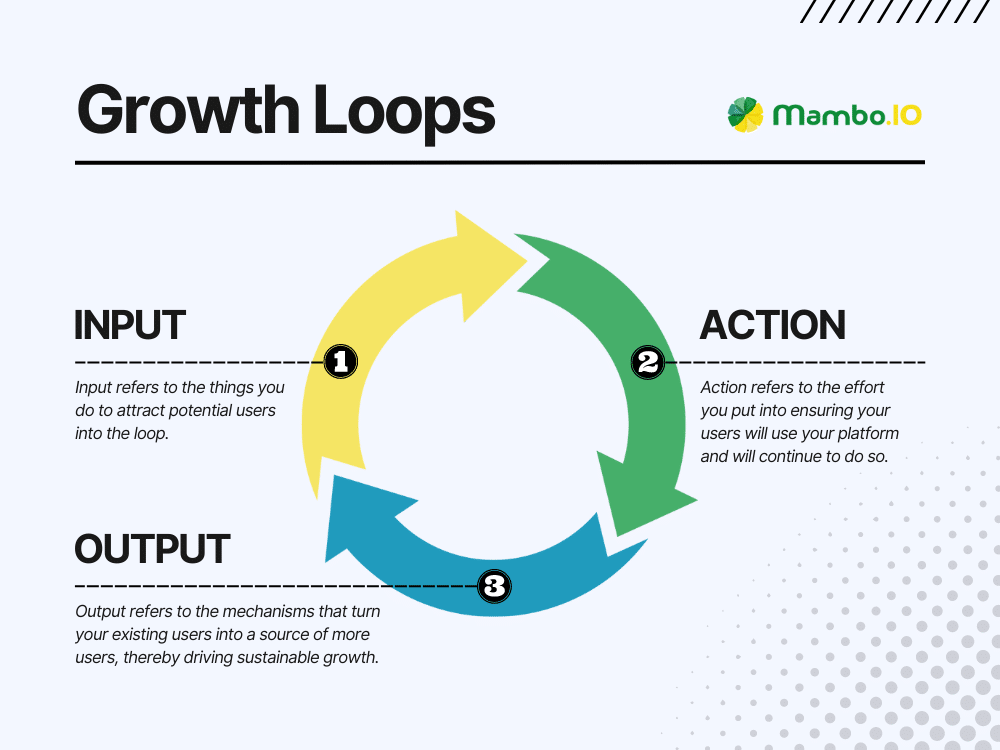
Unlike the sales funnel model, a growth loop cycle only has three components.
#1. Input
The input stage refers to what you do to attract potential users into the loop.
If we compare it to the stages of the sales funnel model, input encompasses the awareness stage.
Common strategies used for this part may include social media posts, articles, and marketing campaigns.
#2. Action
Action correlates to the interest and desire stages of the sales funnel model.
It refers to the effort you put into ensuring your users will use your platform and will continue to do so.
It utilises strategies similar to the funnel model, like free trials, case studies, and a great user experience.
#3. Output
Output refers to the mechanisms that turn your existing users into a source of more users, thereby driving sustainable growth.
Examples of such mechanisms are referral systems, social sharing, and user-generated content.
Once a loop cycle is done, you don’t necessarily have to attract potential users yourself via the input stage again.
If that still sounds confusing, some real-life examples may help clear things up.
Real-life examples of successful growth loops
#1. LinkedIn
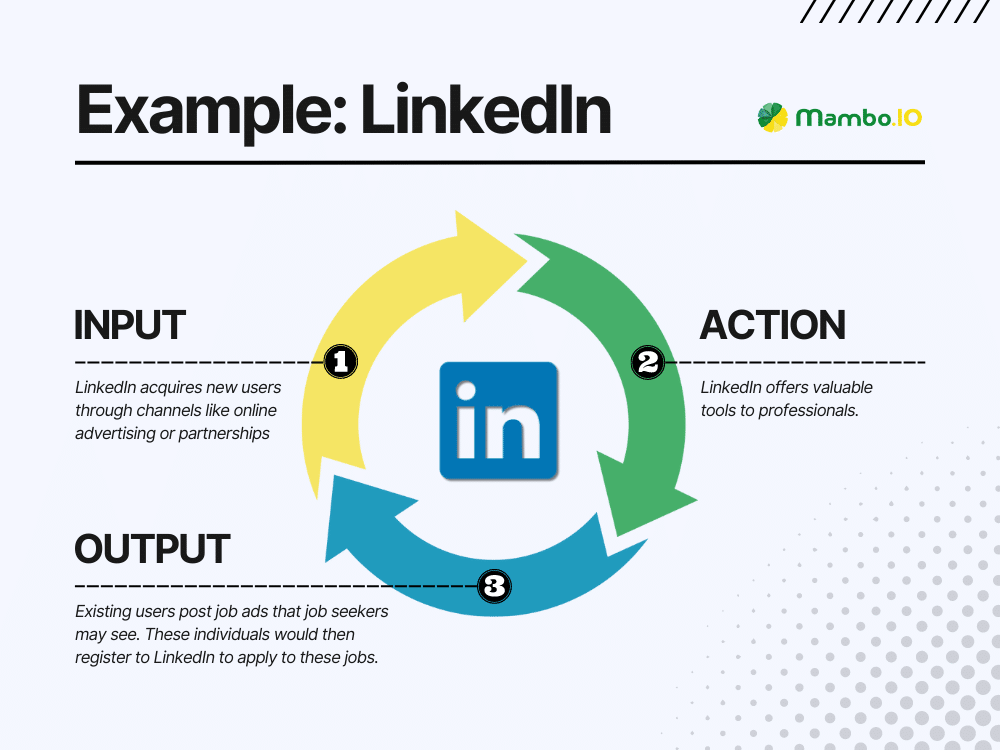
LinkedIn is the world’s largest social networking site on the internet, as far as the business community is concerned. It’s basically like Facebook but for professionals.
Here’s how they incorporate growth loops into their platform.
- Input: LinkedIn occasionally acquired new users through its marketing and sales efforts. Channels they commonly use for this purpose are online advertising and partnerships with job search sites.
- Action: LinkedIn offers numerous tools to professionals that they will likely find helpful. For example, they can connect with other users or post job ads.
- Output: Many of the actions LinkedIn users take tend to create a network effect that often attracts new users. If an employer posts a job ad, for instance, numerous job seekers may find it and apply via LinkedIn. If they get the job, they may then continue using LinkedIn because of the value it has provided.
#2. HubSpot
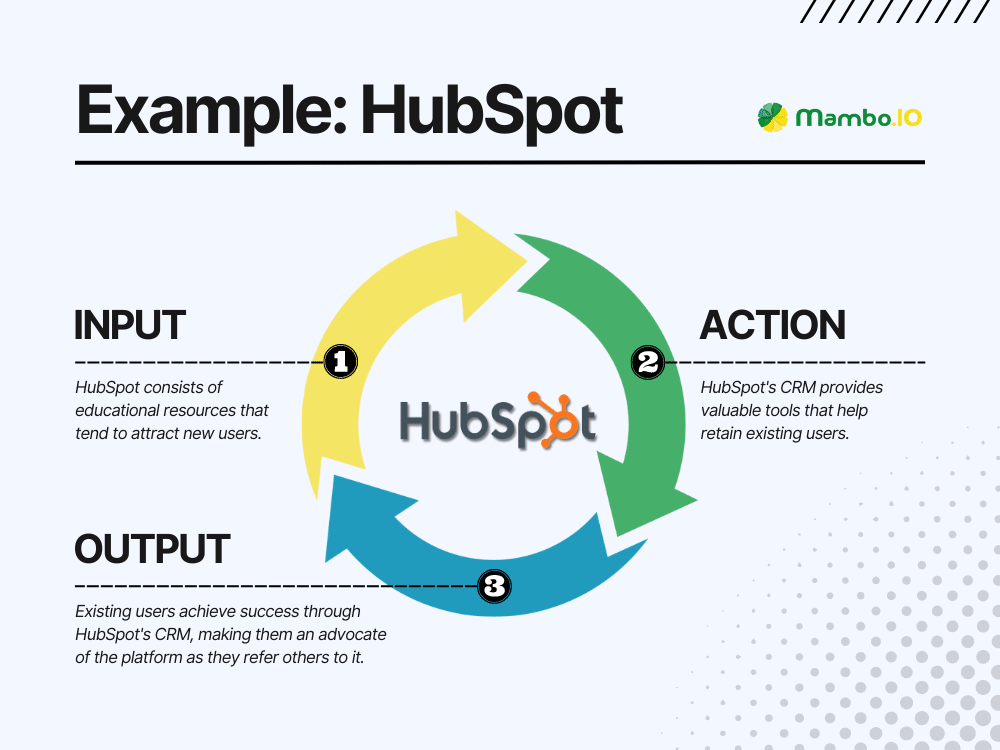
HubSpot offers an excellent CRM with tools that help businesses attract visitors and convert them into users/customers.
Most corporate teams know the company’s name, primarily thanks to HubSpot’s growth loops strategy.
- Input: Most HubSpot users came to know of the company from their valuable tools and educational resources (webinars and blogs).
- Action: HubSpot keeps its users loyal to the platform by offering tools that align with their goals. These may include tools that help automate processes, track key performance indicators (KPIs), or engage with users.
- Output: When users succeed with HubSpot’s tool, they may become advocates and refer others to the platform. As a result, their existing users will act as a built-in marketing tool that advertises HubSpot’s CRM software.
#3. Dropbox
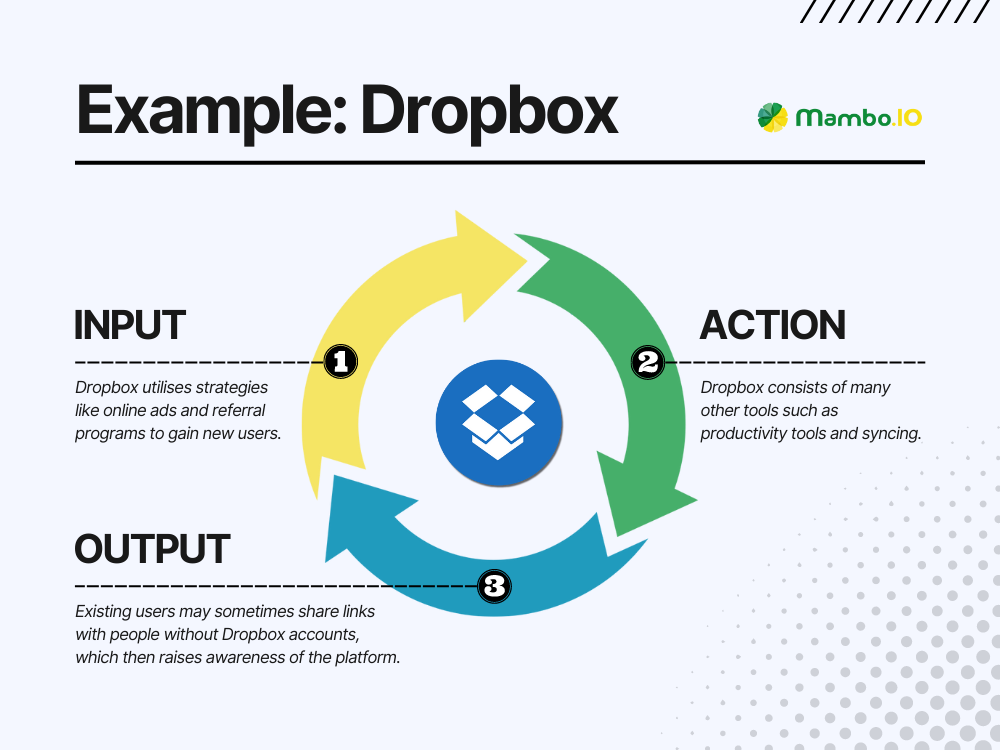
Dropbox enables users to bring every file they need together in one place.
It’s a rather noble idea, really. But their genius doesn’t end there. It can also be seen in Dropbox’s growth strategy.
- Input: Dropbox’s user acquisition growth is nothing special. Like other companies, they utilise content marketing, referral programs, and online ads.
- Action: Outside Dropbox’s file storage capability, it also offers features you will not find on other platforms. Features like collaboration, seamless syncing across devices, and productivity tools keep users loyal to Dropbox.
- Output: The beauty of Dropbox is you can share a file with people that aren’t Dropbox users. It goes like this: you send the link via instant messaging, email, or SMS. The recipient clicks the link and is sent to Dropbox. Upon using the platform, they might take an interest in it and create an account.
#4. G2
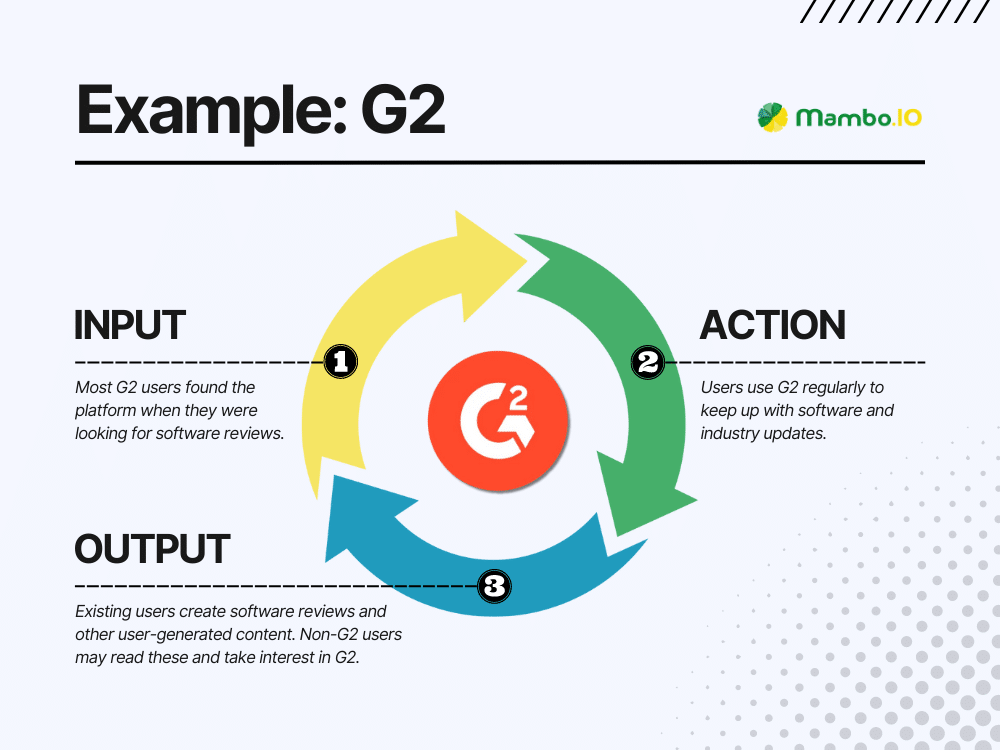
G2 is known in the software industry for providing comprehensive reviews and guides on digital products and services. It’s the go-to site for individuals and even companies when deciding if a particular software is worth the investment or not.
It, too, incorporates a growth loops-based framework seamlessly to drive its growth.
- Input: The majority of G2 users learned about the platform when they were looking for reviews on specific software products. In short, G2 leverages content marketing and search engines to gain users.
- Action: G2 maintains its users with its user-friendly interface and the social factor it provides to its users.
- Output: Most reviews in G2 are not from G2 itself. Instead, those are generated by the existing G2 users. In the best-case scenario, a non-HubSpot internet user would read these reviews. Then, that user signs up and creates an account to keep up with the latest software news updates.
As you can see, all these four examples leverage existing users to drive business growth. But of course, they do this in different ways, and that’s because there are different types of growth loops.
Main types of growth loops
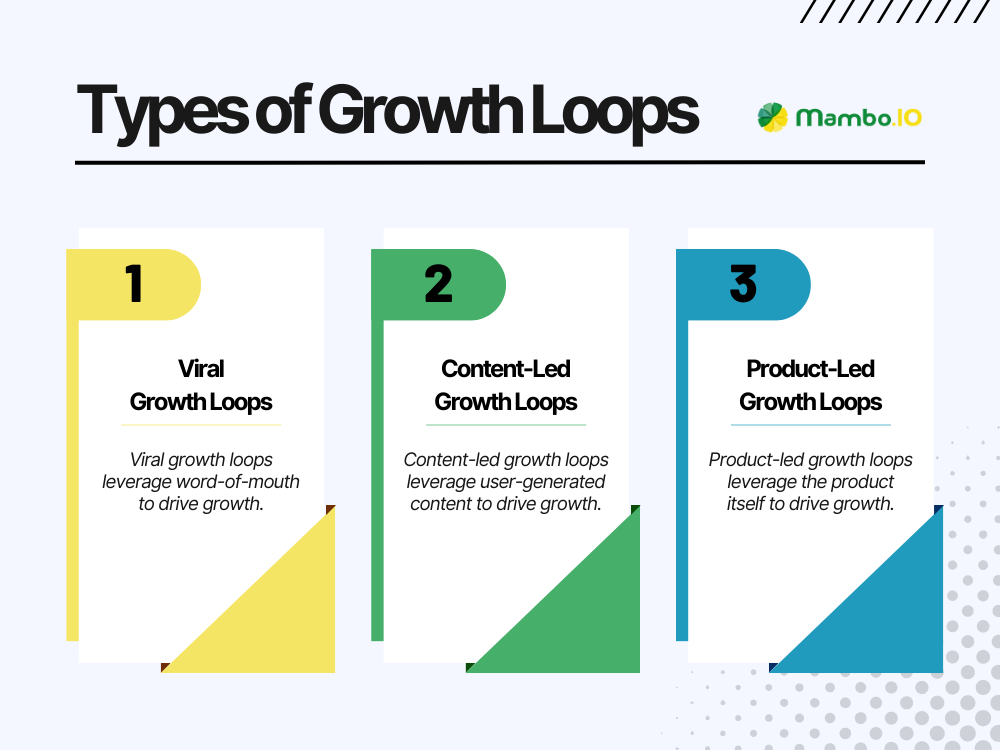
#1. Viral growth loops
Viral growth loops aim to provide as much value to the users as possible.
You do this in hopes that the user will become an advocate of your platform at some point. HubSpot is an example of a company that utilises a viral loop.
HubSpot provides a lot of value to its users. If someone in the user’s networks ever finds the need for CRM software, HubSpot would be their first recommendation.
#2. Content-led growth loops
Content-led growth loops are perhaps the most straightforward type. It refers to any growth strategy that leverages user-generated content to drive growth.
G2 and LinkedIn are examples of companies that use the content-led growth loop model.
In the case of G2, software reviews published by users drive growth.
In the same way, on LinkedIn, job ads posted by users of the platform drive growth.
#3. Product-led growth loops
Product-led growth loops generate new users due to existing users using the product. Simply put, the product’s nature drives growth for the business.
Dropbox is an example of a product growth loop.
By using Dropbox and sharing the link with a non-Dropbox user, you’re essentially marketing the platform. In short, you’re marketing Dropbox by simply using it.
Needless to say, each type is suitable for different kinds of businesses. That’s why an understanding of the concept of growth loops is necessary before you implement it for your business. With that said, how would one usually go about its implementation?
How to implement growth loops in your business
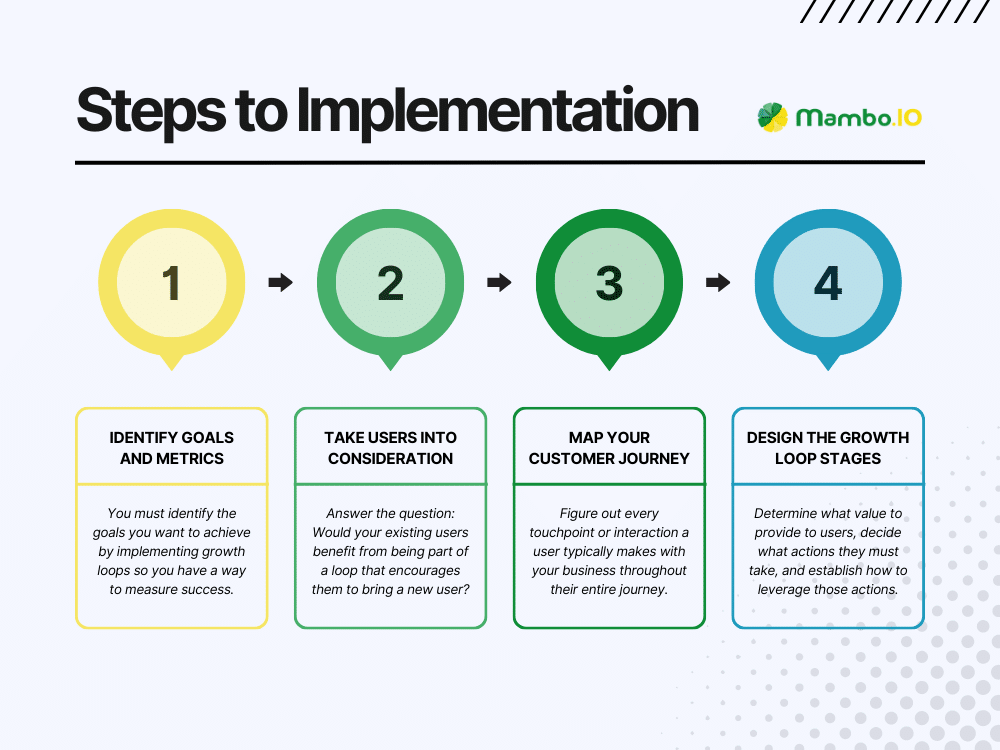
To help you implement growth loops in your business, here’s a breakdown of the steps you’d usually have to take:
#1. Identify goals and metrics
First, you must identify what you aim to achieve by incorporating the growth loops framework. Without a goal, you have no means to measure your success or if you’re successful at all. These goals must be outside of driving sustainable growth.
In the context of growth loops implementation, these goals would typically be one, or a combination, of the following:
- Improve user engagement.
- Maximise user acquisition rate.
- Increase revenue.
- Expand into new user markets.
The most common goal is to acquire new users, in which case, the model would be called an acquisition loop. LinkedIn’s model is an example of an acquisition growth loop.
#2. Take your users into consideration
Another thing you must do before you even consider implementing growth loops is to consider your users. That is to say, you must ask yourself this question:
Would your existing users benefit from being part of a loop encouraging them to bring a new user?
If the answer is no, then unfortunately, growth loops wouldn’t be for you.
Take Airbnb, for example.
An influx of new users means increased competition among hosts. As such, while it does drive growth for the company, it can lead to disadvantages for its existing users.
But if your answer is yes, then you must determine what user benefit that would be.
#3. Map your customer journey
Next, you need to map your customer journey.
Figure out every touchpoint or interaction a user makes with your business throughout their journey.
In doing so, you’ll be able to identify the key stages where you can introduce growth loops to your users.
#4. Design the growth loop stages
At this point, you now have confidence that growth loops would work for your business and your users.
In addition, you know precisely at which point of the customer journey you must incorporate the framework. All that’s left is to design each stage.
- Input – Determine what value you would provide to users.
- Action – Decide what actions these users must take within the platform.
- Output – Establish how you would leverage these user actions to drive growth.
With this, you can seamlessly incorporate the growth loops framework into your existing growth strategy.
It’s also advisable to continuously monitor and analyse the performance of your growth loops. After all, while setting it up is often the hardest part, further optimising it is also part of the job.
The bottom line: growth loops
Growth loops offer a variety of benefits that can even lead to exponential growth. But that’s not to say it works with all kinds of businesses. Some companies will find it incompatible with their business model, like our previous example, Airbnb. On the other hand, we find that gamification is a powerful complement to growth loops.
With Mambo’s gamification APIs, you can encourage specific behaviours and create referral loops so your users can keep coming back. Book your free demo now.
Download your free
“Gamification Guide”
Get your PDF now and start transforming your approach to digital engagement!
Latest Posts
Machine Learning In Finance: 12 Essential Applications
The impact of machine learning on finance is significant. Thanks to this technology, financial institutions are now equipped to make efficient decisions. Through the analysis of data sets, machine learning […]
How To Create Interactive Compliance Training For Bank Employees
Banking compliance training isn’t just another task. It’s the stage where everything else performs. Banks must navigate a myriad of regulations and laws. After all, this is a trust-driven, high-stakes […]
How Fintech Apps Are Using Gamification To Increase User Engagement
Discover how gamification in fintech is revolutionizing financial engagement, making banking fun & boosting user loyalty.





